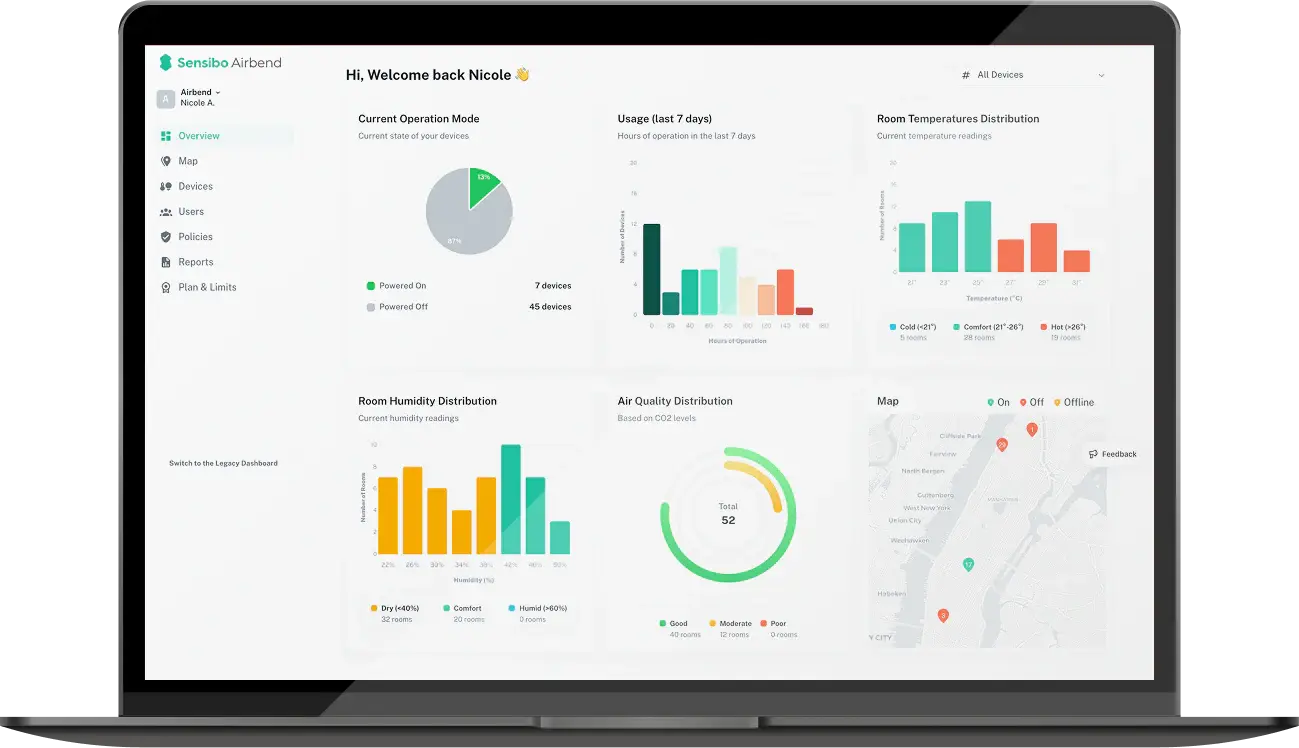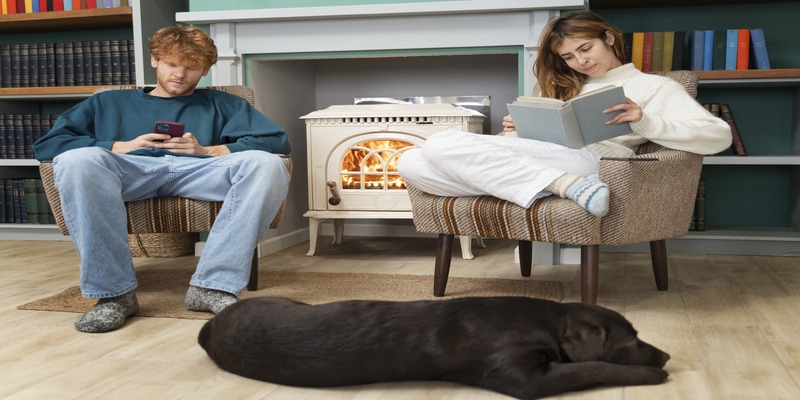Smart AC Controller for a Comfortable Pet Climate at Home
Key Takeaways
- Dogs rely primarily on panting to cool down and only have sweat glands in their paw pads, making them vulnerable to overheating when indoor temperatures rise unexpectedly during the day.
- Indoor temperatures above 78°F for dogs and 85°F for cats can lead to heat stress, respiratory problems, and emergency health situations, especially for flat-faced breeds and senior pets.
- Traditional thermostats create dangerous safety gaps by waiting for temperature problems to occur rather than preventing them, leaving pets uncomfortable or at risk for hours before systems respond.
- Smart AC controllers use real-time weather data, humidity sensors, and predictive algorithms to make proactive temperature adjustments that keep pets safe even when you're away from home.
- Proper automated climate control prevents costly emergency vet visits while reducing household energy consumption by 15-25%, making the systems pay for themselves within months.
Pet owners face a common problem during temperature swings. You leave home when it's comfortable, but weather changes throughout the day. Your house heats up or cools down while you're away at work. Most pets can't handle extreme temperatures well. Dogs overheat quickly. Cats get stressed in hot weather. Both suffer when homes get too cold.
Regular thermostats only react after problems start. They wait until reaching set temperatures before making changes. A smart AC controller works differently. It monitors weather forecasts and adjusts your home's climate before dangerous temperatures affect your pets.
Why Your Pet's Body Works Against Them
Nature's Flawed Cooling System
Ever wonder why dogs pant so much? That's literally their air conditioning system. No joke. While you sweat through your entire skin, dogs only have sweat glands in their paw pads. Imagine trying to cool your whole body through just your feet. Not exactly efficient.
When your Labrador pants, he's evaporating moisture from his lungs. Works okay until the air gets too hot or too humid. Then it's like trying to cool down with a broken fan.
Flat-faced breeds like French Bulldogs got dealt an even worse hand. Their squished airways make panting super inefficient. What might just be "warm" for a German Shepherd could send a Frenchie straight to the emergency vet.
Size matters too. Tiny dogs like Chihuahuas lose heat fast—great in summer, terrible in winter. Giant breeds like Great Danes? They're basically walking furnaces that can overheat even when it feels perfectly fine to you.
The Silent Sufferers
Cats are sneaky about temperature stress. No dramatic panting like dogs. Instead, they lick themselves more when it's hot, spreading saliva for cooling. But this takes energy, and when it's really hot, it actually makes things worse.
Watch your cat on a hot day. They'll sprawl on bathroom tiles, hide under beds, or plaster themselves against cool walls. These aren't quirky behaviors—they're survival tactics.
What temperature is too hot for cats indoors? Most cats start getting stressed around 85°F. By 90°F, you're in the danger zone. Thing is, cats won't show obvious distress until they're already in trouble.
The Fur Coat Problem
Both dogs and cats are stuck wearing fur coats year-round. A Husky doesn't magically shed his winter coat in July. A Persian cat can't take off her fluffy jacket when the heat wave hits.
This creates a nightmare scenario: animals built for specific climates living in houses where the temperature can swing wildly depending on weather, time of day, or whether you remembered to adjust the thermostat before leaving.
Warning signs your pet is overheating:
- Heavy panting (dogs) or open-mouth breathing (cats)
- Drooling more than usual
- Acting sluggish or refusing to move
- Constantly seeking cool surfaces
- Vomiting or loose stools
Why Regular Thermostats Fail to Cool Your Pet
Your basic thermostat is like having a part-time security guard who only shows up after the robbery. It reacts to problems instead of preventing them.
Here's what happens on a typical summer day: You leave for work with the house at a comfortable 74°F. The thermostat's set to kick in at 78°F. Sounds reasonable, right?
Wrong. Afternoon sun heats up your south-facing windows. The living room hits 82°F while your thermostat sensor (usually in a hallway) still reads 76°F. Your pet suffers for hours before the AC finally decides to work.
Then there are the real nightmare scenarios:
- Power outage resets your thermostat to default settings
- You forget to adjust the temp before a weekend trip
- Equipment malfunctions while you're at work
- Seasonal weather swings catch you off guard
Heat-related health emergencies include:
- Dehydration that can damage kidneys permanently
- Heat stroke requiring emergency vet intervention
- Breathing difficulties that can be fatal
- Heart problems getting dangerously worse
Your pet doesn't just get "uncomfortable"—they can die.
 Smart Controllers: Your Pet's 24/7 Bodyguard
Smart Controllers: Your Pet's 24/7 Bodyguard
How This Technology Actually Works
Think of a pet air conditioner system as having eyes, ears, and a brain that never stops watching your home's environment. Multiple sensors track temperature, humidity, and air quality constantly. Not just one reading per hour like old thermostats—we're talking continuous monitoring.
These systems connect to your existing AC through infrared signals (the same technology as your TV remote, but way smarter). When conditions start drifting toward dangerous territory, they spring into action immediately.
But here's where it gets really cool: they don't just react. They predict. Weather forecast shows a heat wave coming? Your system starts pre-cooling your house. Humidity spiking because of afternoon thunderstorms? It adjusts automatically.
The Sensibo Sky Difference
The Sensibo Sky smart ac controller takes pet protection seriously. It sends alerts to your phone the moment temperatures drift outside safe zones. Not when your pet is already in distress—when conditions first start heading that direction.
Game-changing features:
- Custom temperature schedules that match your pet's daily routine
- Automatic adjustments based on weather forecasts
- Emergency protocols that prioritize pet safety over energy savings
- Location tracking that cools your house before you arrive and conserves energy when you leave
Real talk: this isn't just convenience. It's pet insurance that actually prevents emergencies instead of just paying for them after they happen.
Different Pets, Different Needs
Aircon for dogs requires different programming than aircon for cats. Dogs need more aggressive cooling because they're typically more active and can't regulate temperature as efficiently. Cats prefer slightly warmer environments but need precise humidity control.
Multi-zone systems let you customize different areas. Your energetic Border Collie might need the living room kept at 73°F while your senior Persian cat prefers her bedroom at 78°F. No compromises, no pet left uncomfortable.
Getting the Temperature Right for Your Specific Pet
Size and Breed Matter More Than You Think
Temperature sweet spots by dog size:
- Small breeds (under 25 lbs): 70-75°F is perfect, never let it drop below 65°F
- Medium breeds (25-60 lbs): 68-73°F works best, can handle 60-78°F range
- Large breeds (60-90 lbs): 65-72°F is ideal, start worrying above 75°F
- Giant breeds (over 90 lbs): 62-70°F prevents overheating, heat stress kicks in around 73°F
Active dogs generate more body heat. That Border Collie who runs around your backyard all day needs cooler recovery temps than a couch-potato Basset Hound.
They're Not Just Small Dogs
Most house cats find their comfortable temperature between 75-80°F. But breed makes a huge difference. Short-haired cats like Siamese do well around 75-78°F. Long-haired breeds like Maine Coons need it cooler—typically 70-75°F—because their double coats trap heat like crazy.
Senior cats need special attention. Their circulation isn't what it used to be, so they often need temps 2-3 degrees warmer than younger cats to stay comfortable and keep their joints from getting stiff.
The Compromise Game
When you can't do separate zones, you're looking for that sweet spot where everyone's okay. Most mixed households do well keeping things between 72-75°F. Not perfect for every pet, but safe for all.
Strategic pet bed placement helps individual animals fine-tune their comfort. Elevated beds give better air circulation for heat-sensitive dogs. Heated pet beds provide extra warmth for cold-loving cats.
 Beyond Temperature: The Complete Pet Environment
Beyond Temperature: The Complete Pet Environment
Predicting Problems Before They Happen
Smart systems don't just monitor—they anticipate. Weather integration means your AC knows about incoming heat waves before your local news does. The system starts adjusting hours ahead of time.
Machine learning studies your pets' behavior patterns. Does your dog get restless when it hits 74°F? The system learns and starts cooling before he gets uncomfortable. Does your cat always seek out sunny spots on chilly mornings? It adjusts accordingly.
Vacation mode keeps your pets safe during extended trips without wasting energy. Instead of maintaining full comfort for an empty house, it uses pet-safe but efficient settings.
The Hidden Health Factor
Temperature isn't everything. Poor air quality can trigger asthma in sensitive pets or worsen existing respiratory conditions. Smart systems monitor particle levels and automatically increase filtration when needed.
Humidity control prevents both the dry air that irritates pet airways and the excess moisture that promotes bacterial growth. Keeping humidity between 40-60% supports healthy breathing and better coat condition.
Voice commands through Alexa or Google let you make instant adjustments when you spot your pet showing stress signs. "Hey Google, cool down the living room" can provide immediate relief.
The Real-World Impact
Your Wallet Will Thank You
Smart climate control typically cuts energy bills by 15-25% compared to leaving your AC on constantly. Precise temperature management eliminates waste while predictive algorithms optimize efficiency.
Monthly cost comparison:
- Always running AC at 72°F: $180-220
- Basic programmable thermostat: $140-170
- Smart pet-optimized control: $110-135
- Your actual savings: 20-35% monthly
Health Benefits You Can See
Pet owners report fewer emergency vet visits after installing smart climate control. Heat-related health problems drop dramatically when temperature stays consistently safe.
Better sleep patterns emerge when pets aren't fighting temperature swings all night. Consistent comfortable temperatures support deeper rest cycles crucial for pet health.
Coat and skin condition improves with optimal humidity control. Pets not constantly stressed by environmental factors show better grooming habits and healthier appearance.
Peace of Mind You Can't Put a Price On
Real-time monitoring means you always know your pet's environment is safe. Phone alerts tell you immediately if anything goes wrong, giving you time to respond before problems escalate.
Automatic backup systems kick in during equipment failures. Even if your primary AC breaks down, emergency protocols maintain safe temperatures until you can address the issue.
Historical data helps identify patterns that might indicate health issues. Sudden changes in how your pet responds to temperature can be early warning signs worth discussing with your vet.
 Making Your Home Pet-Smart Today
Making Your Home Pet-Smart Today
Easier Than Programming Your Coffee Maker
Modern smart controllers work with any AC that uses a remote. Window units, mini-splits, portable ACs—if it responds to infrared signals, you're good to go.
Aircon for cats and dogs becomes plug-and-play simple. Download the app, scan the QR code on your device, follow the setup wizard. Most people finish in under ten minutes.
App configuration includes preset profiles for different pet types. Start with a template, then customize based on your specific animals' needs and behaviors.
Choosing Your Pet's Guardian
Must-have features:
- Temperature precision: Accuracy within 1°F isn't negotiable
- Humidity monitoring: Critical for pets with breathing issues
- Air quality sensors: Game-changer for homes with allergic pets
- Emergency alerts: Your safety net when things go wrong
Budget options cover essential protection. Premium systems add advanced monitoring and smart home integration. Either way, your pet gets protection that manual thermostats simply can't provide.
FAQ
Will a smart AC controller work with my existing air conditioner?
Most smart AC controllers work with any air conditioner that uses an infrared remote control, including window units, mini-splits, and portable ACs. Simply check if your AC responds to a remote—if yes, it's likely compatible.
How much can I save on energy bills with smart pet climate control?
Smart climate control typically reduces energy consumption by 15-25% compared to constant manual operation, saving most households $30-80 monthly. The system pays for itself within 6-12 months through optimized temperature management.
Is it safe to leave my pet alone with automated climate control?
Yes, smart controllers are designed with multiple safety features including emergency alerts, backup protocols, and fail-safes that prioritize pet safety. They're significantly safer than manual thermostats because they provide constant monitoring and immediate alerts.
What's the ideal temperature range for most pets when I'm away from home?
For dogs, maintain 75-78°F when away (never above 82°F), while cats can tolerate 78-82°F safely. Adjust these ranges based on your pet's size, breed, and health condition—senior and small pets need temperatures on the warmer end.
How quickly can I set up a smart AC controller for my pet's safety?
Most systems install in under 10 minutes with no tools required—simply plug in the device, download the app, and scan the QR code. Pet-specific temperature profiles can be configured immediately through preset options in the mobile app.



































.jpg?height=200&name=photo_2024-01-16_18-35-46%20(1).jpg)
.png?height=200&name=image_2024-07-12_20-06-11%20(1).png)

